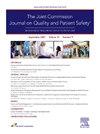Use of the Model for Improvement to Reduce Hyperglycemia in Adult Patients Admitted to a Public Tertiary Care Hospital
IF 2.4
Q2 HEALTH CARE SCIENCES & SERVICES
Joint Commission journal on quality and patient safety
Pub Date : 2025-01-20
DOI:10.1016/j.jcjq.2025.01.004
引用次数: 0
Abstract
Background
The objective of this study was to reduce by 50% the occurrence of average daily blood glucose (ADBG) > 180 mg/dL among noncritical patients admitted to a surgical ward at a public tertiary care hospital.
Methods
This project ran from April 2022 to June 2023 and used the Model for Improvement (MFI) method. Health care Failure Modes and Effects Analysis was used to identify and analyze failure modes in hyperglycemia management, and a driver diagram (DD) was used to prioritize and structure changes. The Plan-Do-Study-Act (PDSA) tool facilitated the change process. Data were collected using standardized forms and monitored with run charts, considering process, outcome, and balance indicators. The DD included 12 changes focusing on protocol implementation, adequate medical prescription, correct insulin administration, proper blood glucose monitoring, appropriate diet prescription, safe care transitions between units, routine of publication and discussion of indicators, leadership engagement with frontline workers on hyperglycemia management, educational actions, and defining roles and responsibilities.
Results
A 69.0% reduction in ADBG > 180 mg/dL and a 100% reduction in ADBG > 300 mg/dL were achieved, though hypoglycemic events increased from 8 to 11 per 100 patient-days using insulin or oral antidiabetic medications. Reductions in nonconformities in medical prescription and insulin administration (50.0% and 71.4%, respectively) were also achieved.
Conclusion
In this pilot project, use of the MFI led to improved prescription practices, insulin administration, and blood glucose control, reducing the rate of hyperglycemia in hospitalized patients.
利用改进模型降低公立三级医院住院成人患者的高血糖。
背景:本研究的目的是减少50%的发生平均每日血糖(ADBG) bb0 180 mg/dL在公立三级护理医院外科病房的非重症患者。方法:研究时间为2022年4月至2023年6月,采用改进模型(MFI)方法。医疗保健失败模式和影响分析用于识别和分析高血糖管理的失败模式,并使用驱动图(DD)来确定优先级和结构变化。计划-执行-研究-行动(PDSA)工具促进了变革过程。使用标准化表格收集数据,并使用运行图进行监测,同时考虑过程、结果和平衡指标。DD包括12项变化,重点是方案实施、充足的医疗处方、正确的胰岛素给药、适当的血糖监测、适当的饮食处方、单位之间的安全护理过渡、常规的出版和指标讨论、领导与一线工作人员在高血糖管理方面的参与、教育行动以及定义角色和责任。结果:在使用胰岛素或口服降糖药的情况下,每100患者日发生的低血糖事件从8例增加到11例,但在180 mg/dL ADBG下降69.0%,300 mg/dL ADBG下降100%。药物处方和胰岛素给药不合格率分别降低了50.0%和71.4%。结论:在这个试点项目中,MFI的使用改善了处方实践、胰岛素给药和血糖控制,降低了住院患者的高血糖率。
本文章由计算机程序翻译,如有差异,请以英文原文为准。
求助全文
约1分钟内获得全文
求助全文
来源期刊

Joint Commission journal on quality and patient safety
HEALTH CARE SCIENCES & SERVICES-
CiteScore
3.80
自引率
4.30%
发文量
116
审稿时长
49 days
 求助内容:
求助内容: 应助结果提醒方式:
应助结果提醒方式:


